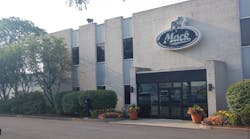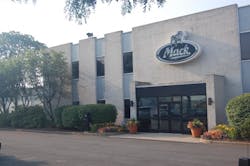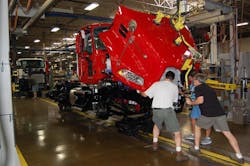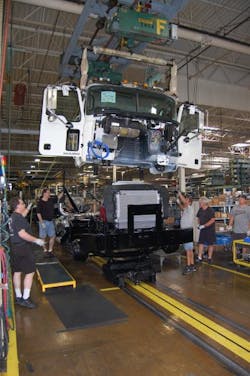For example, take the word “Macungie” itself; the name of the town in the Lehigh Valley region of Pennsylvania and home to Mack’s truck-making endeavors since 1905, when the Mack brothers relocated from the Brooklyn section of New York city.
A Native American word, “Macungie” literally means the “eating place of bears” as when food became scarce along the eastern edge of the Appalachian mountains bordering the Lehigh Valley, the bears would descend down the slopes to fill their hungry bellies.
[To view more photos of the Macungie facility, please click here.]
These days, of course, you won’t find many bears wandering about Macungie, but you will see an awful lot of bulldogs decorating quite a few truck hoods.
The current iteration of Mack’s Macungie plant dates back to 1975. Built for the then-princely sum of $25 million, the 930,000 sq.-ft. factory today houses two chassis assembly lines, three cab assembly lines, an engine groom line, a modification center, a tire warehouse, a final department and a parts warehouse.
[National Geographic paid the plant a visit not long ago to film the Macungie operations for its Ultimate Factories TV series. You can watch a clip from that program below.]
Altogether the plant produces 12 different Mack truck models and employs 1,695 workers: a vast improvement from the 652 that staffed the facility back in December 2008.
One of the interesting things about the manufacturing sector in the U.S. these days is how “green” companies are trying to make their plants in terms of reducing energy consumption and shrinking their waste streams.
At Mack’s Macungie plant, for example, the company is targeting reductions landfill waste by 2% every year and relies on a “waste hunters” cross-functional team made up of both management and hourly employees to explore new opportunities in recycling. The result is a reduction of waste to landfill per unit of 30% – from 199.9 pounds per unit in 2004 to 139 pounds per unit in 2006, the company noted.How does such a reduction occur? First by using more “returnable containers” for the shipment of various components (indeed some 70% of the containers used by the plant today are now returnable) and second by recycling more of the packaging and part “leftovers” such as wood, cardboard, metals, paper, plastics, etc.
Chew on these numbers for a moment. In 2011, the Macungie plant recycled 440 tons of cardboard (more than 36 tons per week) and 200 tons or scrap metal (some 16.5 tons per week). The factory also recycled 54 tons of paper last year, along with 25 tons of clear plastics.
Another “recycling effort” currently under evaluation is an process to use shredded wood waste as feedstock for biofuel generation, as wood waste accounts for approximately 64% of all of the trash Macungie sends to landfill.Then there’s cutting back on energy use itself. From 2003 to 2006, Macungie reduced its overall energy usage by 21.6% – more than 11 million kilowatts per hour – by another 48% between 2004 and 2009.
Mack accomplished such energy reduction in several ways. For instance, it installed extra roof openings to provide more “natural light” versus light supplied by electricity, and is painting much of its ceiling space white to increase the brightness provided by such “natural light” as well.
Natural gas has also replaced many of the old oil-fed boilers and air handlers in the factory to help reduce a variety of emissions: virtually eliminating oxides of sulfur (SOx), cut back on oxides of nitrogen (NOx); and slash carbon dioxide (CO2) emissions by 63% overall since 2002.
While all of those “green” efforts certainly benefit the environment, they also save Mack a lot of money – helping it reduce the cost of truck building operations. Can’t argue with that strategy as the economy continues to stay stuck in “slug mode,” which is keeping margins tight for everyone up and down the trucking food chain.






